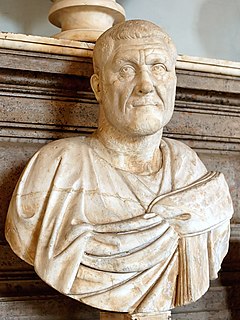Related Research Articles
The 230s decade ran from January 1, 230, to December 31, 239.

Year 238 (CCXXXVIII) was a common year starting on Monday of the Julian calendar. At the time, it was known as the Year of the Consulship of Pius and Pontianus. The denomination 238 for this year has been used since the early medieval period, when the Anno Domini calendar era became the prevalent method in Europe for naming years.

Gordian III was Roman emperor from AD 238 to 244. At the age of 13, he became the youngest sole Roman emperor. Gordian was the son of Antonia Gordiana and Junius Balbus who died before 238. Antonia Gordiana was the daughter of Emperor Gordian I and younger sister of Emperor Gordian II. Very little is known of his early life before his acclamation. Gordian had assumed the name of his maternal grandfather in 238 AD.

Gordian I was Roman Emperor for 21 days with his son Gordian II in 238, the Year of the Six Emperors. Caught up in a rebellion against the Emperor Maximinus Thrax, he was defeated by forces loyal to Maximinus, and he committed suicide after the death of his son.

Marcus Didius Julianus was Roman emperor for nine weeks from March to June 193, during the Year of the Five Emperors.

Balbinus was Roman emperor with Pupienus for three months in 238, the Year of the Six Emperors.

Pupienus was Roman emperor with Balbinus for three months in 238, during the Year of the Six Emperors. The sources for this period are scant, and thus knowledge of the emperor is limited. In most contemporary texts Pupienus is referred to by his cognomen "Maximus" rather than by his second nomen Pupienus.
The Gallienus usurpers were the usurpers who claimed imperial power during the reign of Gallienus. The existence of usurpers during the Crisis of the Third Century was very common, and the high number of usurpers fought by Gallienus is due to his long rule; 15 years was a long reign by the standards of the 3rd century Roman Empire.

The Valentinianicdynasty or Valentinian dynasty was a ruling house of five generation of dynasts, including five Roman emperors during Late Antiquity. They succeeded the Constantinian dynasty and reigned over the Roman Empire from 364 to 392 and from 424 to 455, with an interregnum (392–424), during which the Theodosian dynasty ruled and eventually succeeded them. The Theodosians ruled concurrently in the east after 379.
The Year of the Six Emperors was the year 238 AD, during which six men were recognized as emperors of Rome.
Antonia Gordiana was a prominent, wealthy and noble Roman woman who lived in the troubled and unstable 3rd century. She was the daughter of Roman Emperor Gordian I; sister to Roman Emperor Gordian II and mother to Roman Emperor Gordian III. Gordiana’s mother may be the granddaughter of Greek Sophist, consul and tutor Herodes Atticus.

The history of the Roman Empire covers the history of ancient Rome from the fall of the Roman Republic in 27 BC until the abdication of Romulus Augustulus in AD 476 in the West, and the Fall of Constantinople in the East in AD 1453. Ancient Rome became a territorial empire while still a republic, but was then ruled by Roman emperors beginning with Augustus, becoming the Roman Empire following the death of the last republican dictator, the first emperor's adoptive father Julius Caesar.
Marcus Pupienus Maximus was a Roman senator.
Marcus Pupienus Africanus Maximus was a Roman Senator. He was consul ordinarius in 236 as the colleague of Emperor Maximinus I (Thrax). Maximus was the son of Pupienus, later Emperor, and Sextia Cethegilla.
Titus Clodius Pupienus Pulcher Maximus was a Roman politician. He was appointed Consul Suffectus in 224 or 226, or perhaps in July 235.
Marcus Ulpius Eubiotus Leurus was a Roman senator, who was active during the first part of the third century. He was suffect consul in one of the nundinia around the year 230. He is known entirely from inscriptions.

Maximinus Thrax or Maximinus I was Roman emperor from 235 to 238.
The Siege of Aquileia is a siege battle that took place in 238 in the town of Aquileia during the Year of the Six Emperors which resulted in the assassination of Maximinus Thrax.

The Gordian dynasty, sometimes known as the Gordianic dynasty, was short-lived, ruling the Roman Empire from 238–244 AD. The dynasty achieved the throne in 238 AD, after Gordian I and his son Gordian II rose up against Emperor Maximinus Thrax and were proclaimed co-emperors by the Roman Senate. Gordian II was killed by the governor of Numidia, Capillianus and Gordian I killed himself shortly after, either 21 or 36 days after he was declared emperor. On 22 April 238, Pupienus and Balbinus, who were not of the Gordian dynasty, were declared co-emperors but the Senate was forced to make Gordian III a third co-emperor on 27 May 238, due to the demands of the Roman people. Maximinus attempted to invade Italy but he was killed by his own soldiers when his army became frustrated. After this, the Praetorian Guard killed Pupienus and Balbinus, leaving Gordian III as the sole emperor. Gordian III ruled until 244 AD when he was either killed after his betrayal by Philip the Arab, killed by Philip the Arab or killed at the Battle of Misiche; with his death, the dynasty was ended and Philip the Arab became emperor.
References
| This ancient Roman biographical article is a stub. You can help Wikipedia by expanding it. |